I’ve been using a Microsoft Surface Pro 3 ( a 2in1 hybrid tablet/laptop pc ) for a few months now, and I thought this would be a good time to share some feedback.
The Surface Pro 3 I bought is equipped with an Intel Core i5 CPU, 256 GB SSD and 8 GB ram. I chose this version because I wanted a good CPU that will last me a year or 3, and enough disk space to comfortably store stuff. It’s the laptop that I tote with me just about everywhere.
Here are some bullet points that capture my feelings towards it:
– WEIGHT : it’s incredibly light, my backpack feels almost empty, especially compared to when I take my (2011) Apple Macbook Pro. The current Macbook Pro weighs a lot less, and against a Macbook Air the weight difference is almost negligible ( Surface 3 is 2.42 pounds (with keyboard) against the Air’s 2.96 pounds). It’s a handy carrying size.
– SCREEN : the screen is big enough and with a high enough DPI to really make your pictures and movies ‘pop’. I love it.
– DRAWING : I originally bought the Surface Pro 3 for the included N-Trig pen, as I wanted to take notes, and I always wanted to learn how to properly draw. I’ve found out that I’m not using it as much as I want to, although note taking works fine it’s something that I will have to get used to. I’ve bought Clip Studio Paint to draw with, which works fine if you want to freeform draw. But what I’m really looking for is a ‘webdesigner’ vector drawing program that is usable with gestures and touch. On the mac I would go for iDraw, Artboard or Sketch. On Windows 8 I can’t really find a similar program except for Inkscape and the now-defunct Microsoft Design which isn’t fully touch-compliant. Adobe Illustrator or the now defunct Fireworks seem good alternatives, but they cost too much for my limited usage of them.
– WINDOWS 8.1 : using it with Touch it now makes sense. Suddenly everything is much more intuitive. I didn’t really understand how to work Windows 8.1 until I started using it on a touch-capable laptop. It all makes sense : the charms, the swipe up or down, swipe from left to get to your previous app – it all works beautifully. I even started swiping the screen on my mac (to my great frustration). Touch really adds an intuitive dimension, and I for one am waiting for Apple to add it to their laptops.
– HARDDISK SIZE : 256GB for an SSD is plenty of space. Although it is filled up for about half of it’s size already, now that most programs are installed, there should not be a lot of extra disk space needed, bar a few games now and then. I’ve bought a Sandisk 128 GB memory card from amazon on which I store music, movies and some less-frequently used software. If I need the soft I move it first to the SSD – launching from there is very slow, but that is probably more due to the micro sd card.
– PERFORMANCE : I really can’t fault the performance of the Surface, there are no hiccups, everything runs smoothly, even QGIS and a few games on it. The i5 Surface has a Intel 4400 graphics card. While some older graphic-intensive games do work (Fallout 3, Divinity Original Sin), in general they make the fan go on and the Surface gets really hot. You can certainly play games (a few of the best can be found in the Windows store AND are adapted for touch), but it’s best to limit yourself to some less graphic intensive games.
– KEYBOARD : the clip-on keyboard really should be integrated in the price – without one, you are buying an over-priced tablet. With one, the ensemble of tablet + keyboard is still pricey but you suddenly have a good laptop as well. The keyboard is ok, the keys have a bit of a good give and I would not want to work on this keyboard day and night like I would with my macbook pro, but they suffice well for travelling.
– BUGS: there were some initial bugs (not sleeping, not waking, iffy wifi connectivity) that were not immediately solved which garnered quite a bad press. Since then there have been several firmware releases that have solved the majority of the bugs. I only experienced the limited wifi issue in the beginning, but after an update this bug went away. However, it still (very infrequently) comes up and the only solution is to reboot the system (which goes fairly fast, but is still a hassle for such a pricey beast as this one).
My current conclusion :
All in all, I’m very happy with my purchase. It is a very fine fully featured travelling computer with enough space to store all your stuff in. I absolutely love the intuitive way of working with a touch display and hope that Windows 10 will keep this functionality (or I won’t be upgrading). I like Windows 8.1 in it’s Touch-enabled version quite a lot more than on a regular laptop, but in all honesty I still prefer the Apple desktop as I have more experience with that and it makes more sense to me.
If Apple would add a touch screen to their new or future macbook (one that I can draw or write upon with a pen) that would probably be my next buy instead of a Surface 4. Since that won’t be the case for quite some time or maybe for ever, I will continue using my very nice 2-in-1 hybrid tablet / laptop.




